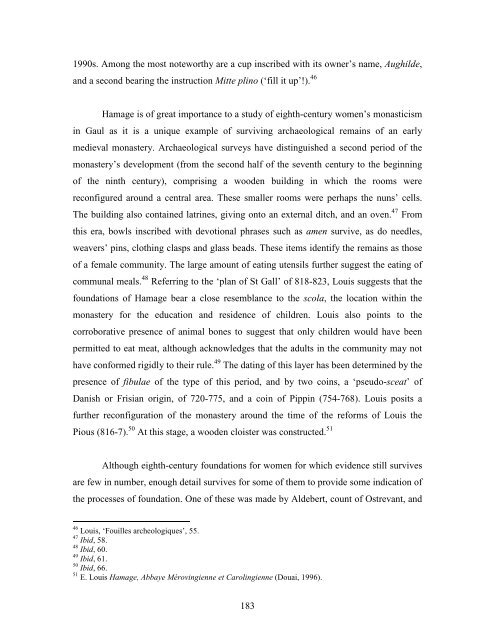Lindsay Rudge PhD Thesis - University of St Andrews
Lindsay Rudge PhD Thesis - University of St Andrews
Lindsay Rudge PhD Thesis - University of St Andrews
You also want an ePaper? Increase the reach of your titles
YUMPU automatically turns print PDFs into web optimized ePapers that Google loves.
1990s. Among the most noteworthy are a cup inscribed with its owner’s name, Aughilde,<br />
and a second bearing the instruction Mitte plino (‘fill it up’!). 46<br />
Hamage is <strong>of</strong> great importance to a study <strong>of</strong> eighth-century women’s monasticism<br />
in Gaul as it is a unique example <strong>of</strong> surviving archaeological remains <strong>of</strong> an early<br />
medieval monastery. Archaeological surveys have distinguished a second period <strong>of</strong> the<br />
monastery’s development (from the second half <strong>of</strong> the seventh century to the beginning<br />
<strong>of</strong> the ninth century), comprising a wooden building in which the rooms were<br />
reconfigured around a central area. These smaller rooms were perhaps the nuns’ cells.<br />
The building also contained latrines, giving onto an external ditch, and an oven. 47 From<br />
this era, bowls inscribed with devotional phrases such as amen survive, as do needles,<br />
weavers’ pins, clothing clasps and glass beads. These items identify the remains as those<br />
<strong>of</strong> a female community. The large amount <strong>of</strong> eating utensils further suggest the eating <strong>of</strong><br />
communal meals. 48 Referring to the ‘plan <strong>of</strong> <strong>St</strong> Gall’ <strong>of</strong> 818-823, Louis suggests that the<br />
foundations <strong>of</strong> Hamage bear a close resemblance to the scola, the location within the<br />
monastery for the education and residence <strong>of</strong> children. Louis also points to the<br />
corroborative presence <strong>of</strong> animal bones to suggest that only children would have been<br />
permitted to eat meat, although acknowledges that the adults in the community may not<br />
have conformed rigidly to their rule. 49 The dating <strong>of</strong> this layer has been determined by the<br />
presence <strong>of</strong> fibulae <strong>of</strong> the type <strong>of</strong> this period, and by two coins, a ‘pseudo-sceat’ <strong>of</strong><br />
Danish or Frisian origin, <strong>of</strong> 720-775, and a coin <strong>of</strong> Pippin (754-768). Louis posits a<br />
further reconfiguration <strong>of</strong> the monastery around the time <strong>of</strong> the reforms <strong>of</strong> Louis the<br />
Pious (816-7). 50 At this stage, a wooden cloister was constructed. 51<br />
Although eighth-century foundations for women for which evidence still survives<br />
are few in number, enough detail survives for some <strong>of</strong> them to provide some indication <strong>of</strong><br />
the processes <strong>of</strong> foundation. One <strong>of</strong> these was made by Aldebert, count <strong>of</strong> Ostrevant, and<br />
46<br />
Louis, ‘Fouilles archeologiques’, 55.<br />
47<br />
Ibid, 58.<br />
48<br />
Ibid, 60.<br />
49<br />
Ibid, 61.<br />
50<br />
Ibid, 66.<br />
51<br />
E. Louis Hamage, Abbaye Mérovingienne et Carolingienne (Douai, 1996).<br />
183

















